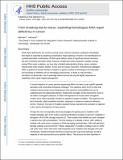From Breaking Bad to Worse: Exploiting Homologous DNA Repair Deficiency in Cancer
Author(s)
Hemann, Michael
DownloadHemann_From breaking.pdf (84.29Kb)
OPEN_ACCESS_POLICY
Open Access Policy
Creative Commons Attribution-Noncommercial-Share Alike
Terms of use
Metadata
Show full item recordAbstract
DNA repair deficiencies are common among cancer cells and represent a potential vulnerability that might be exploited by targeting compensatory repair pathways. However, the identification of synthetically lethal combinations of DNA repair defects, although of significant clinical relevance, has been somewhat anecdotal. Although numerous models have been proposed to explain synthetic lethality among DNA repair mutations, we have only a limited understanding of why a given mutation should render cells sensitive to another. In this issue of Cancer Discovery, Dietlein and colleagues define a general connection between mutations in genes involved in homologous recombination and sensitivity to inhibitors of non-homologous end joining. In doing so, they provide a mechanism to demarcate a set of seemingly diverse tumors that may be highly responsive to established DNA repair–targeted therapeutics.
Date issued
2014-05Department
Massachusetts Institute of Technology. Department of Biology; Koch Institute for Integrative Cancer Research at MITJournal
Cancer Discovery
Publisher
American Association for Cancer Research
Citation
Hemann, M. T. “From Breaking Bad to Worse: Exploiting Homologous DNA Repair Deficiency in Cancer.” Cancer Discovery 4, no. 5 (May 1, 2014): 516–518.
Version: Author's final manuscript
ISSN
2159-8274
2159-8290